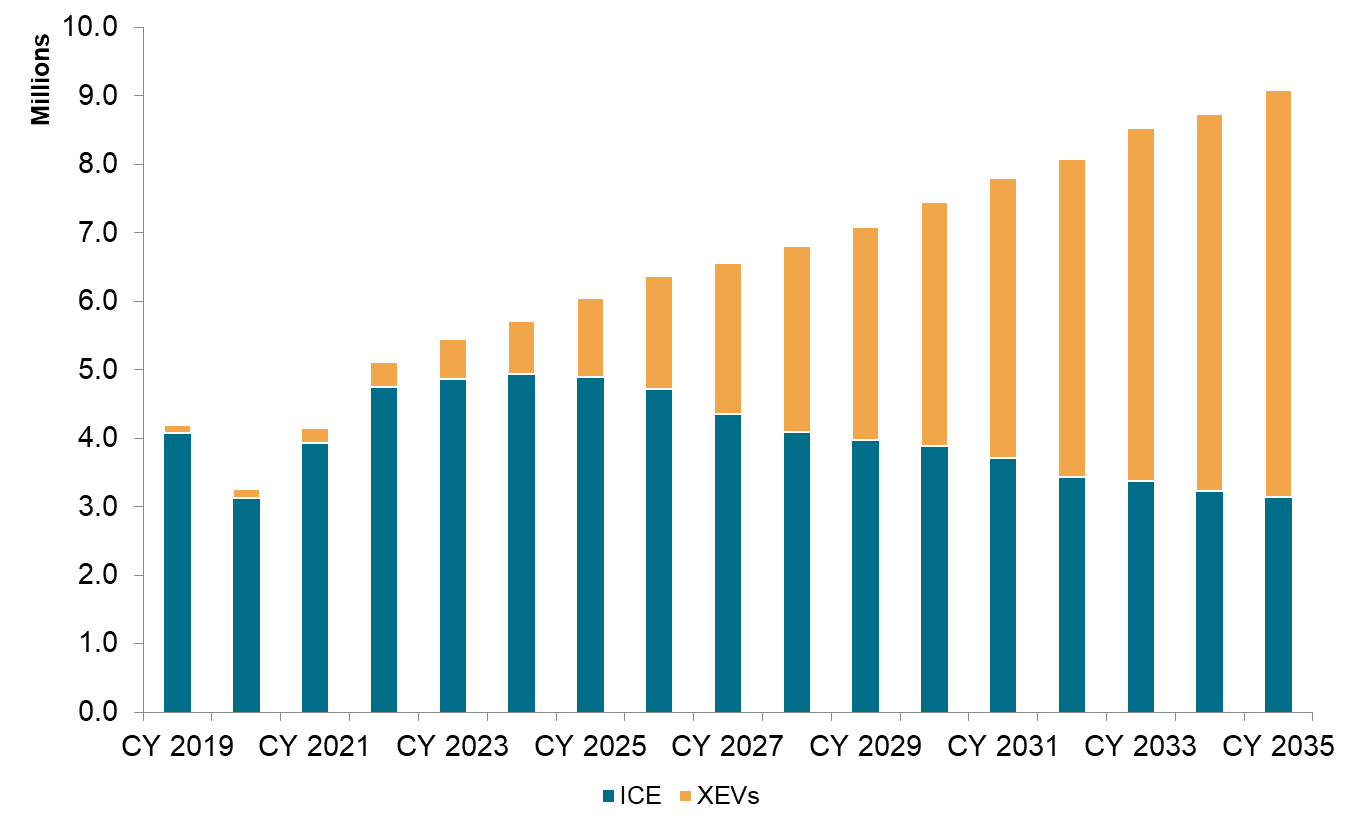Despite infrastructure and manufacturing challenges that could
temper the pace of electric vehicle (EV) adoption, India's large
domestic automotive market, low existing EV penetration rates, and
increasing production capacity make it an attractive destination
for automakers and suppliers.
If Tata Motors' and Mahindra's success in navigating the
pandemic and semiconductor shortages is any indication, India is
expected to become a major player in global light vehicle
production. Furthermore, with global supply chain disruptions and
the return of protectionism, India's position as an export base for
mature markets is becoming increasingly viable.
Potential of India Automotive Industry to Bridge Gaps in Global
Supply Chain
Source: S&P Global Mobility Light
Vehicle Production Forecast
The Resilience of India Automotive Industry
While major markets like mainland China, the United States, and
Germany grappled with production setbacks during disruptions caused
by COVID-19 and semiconductor shortages, automotive industry in
India showed resilience. Indian automotive OEMs demonstrated a
stronger capability to secure semiconductor supplies despite having
lower purchasing power compared to global car manufacturers and
offering fewer features in their vehicles.
India's high GDP growth rate, which is further projected to
remain over 6% between 2026 and 2031, significantly higher than the
global average of 2.7%. India's domestic automotive market is a
significant draw for global automakers. As the 3rd largest market
in light vehicle sales and the 4th largest in light vehicle
production, India's low car penetration rate of just 38 vehicles
per 1,000 people presents a massive opportunity for the automotive
industry of India. According to
S&P Global Mobility Light Vehicle Production Forecasts,
production capacity is expected to rise from 6.8 million units in
2023 to 10 million by 2031, further solidifying India's role in the
global automotive landscape.
Concurrently, the US and EU's increased tariffs on Chinese EVs
have created a void that India is well-positioned to fill. With its
stable supply chain, light vehicle production growth in India is
expected to maintain a steady pace. S&P Global Mobility
projects a growth rate of 4 percent for 2024, with longer-term
expectations of growth stabilizing between 4% and 6% annually
through 2031.
A significant driver of this growth is the anticipated increase
in exports from major manufacturers like Maruti Suzuki and Hyundai,
which may benefit from the growing demand for affordable vehicles
in emerging markets.
Suzuki, for example, aims to ramp up production to 4 million
units by 2031, with a focus on hybrids and EVs.
India Light Vehicle Production, xEV vs. ICE
Data compiled: 8th July 2024.
Source: S&P Global Mobility.
XEVs = Mild Hybrid electric vehicle (MHEV)+ Hybrid
electric vehicle(HEV)+Plug in Hybrid vehicle (PHEV)+Range extender
electric vehicle (REX)+Battery Electric Vehicle (BEV)
Transition of India Automotive Industry to Clean
Technologies
India's automotive landscape is also shifting towards EVs. The
share of internal combustion engine (ICE) vehicles produced in
India is projected to decrease dramatically, from 97% in 2019 to
around 35% by 2035. The implementation of stricter emission
standards like the Bharat Stage 6 (BS6) and upcoming BS 7 norms
have pushed manufacturers to innovate and transition towards
cleaner technologies.
India automotive market is also witnessing a corresponding rise
in the adoption of low emission vehicles like xEVs. Demand for
hybrid electric vehicles (HEVs) and battery electric vehicles
(BEVs) is expected to grow substantially, with a notable increase
in hybrid, range extender vehicles and plug-in hybrid vehicles in
the short term.
However, the current state of infrastructure, particularly the
availability of charging stations and the overall EV ecosystem in
India automotive industry, could temper the pace of EV adoption.
Consumers and automakers are still somewhat cautious in the current
EV landscape. There is a noted delay in adopting new models and
platforms due to uncertainty surrounding regulatory conditions,
like the aforementioned BS7 emission norms.
High costs associated with early-stage EV manufacturing have
also led to rising vehicle prices, raising concerns about
affordability among first-time buyers. The increase in discounts
for ICE vehicles amid consumer trepidation and high inventory
levels could further slow the rate of adoption in the immediate
future.
Even with these mid-term pressures, the trend is unmistakable.
Vehicle manufacturers in India are increasingly adopting
multi-energy platforms that can support both internal combustion
engine (ICE) vehicles and EVs. Over the next few years, these
platforms are expected to increase in the market, setting the stage
for the eventual rise of dedicated EV platforms. Overall, the
long-term outlook for EVs in India is positive. As infrastructure
improves and consumer concerns are addressed, EV adoption is likely
to accelerate, according to S&P Global Mobility forecasts.
As India automotive industry is in the midst of a technological
revolution, there is also a heightened emphasis on supply chain
management. Innovations like ADAS (Advanced Driver Assistance
Systems), software-defined vehicles, and AI (Artificial
Intelligence) are becoming standard features, which require OEMs to
integrate these components into their supply chain.
This article is part of a series featuring highlights from
S&P Global Mobility's 2024 Solutions Webinar Series. The
webinar, India's Light Vehicle Production Outlook and Tata Motors'
Supply Chain Resiliance, occurred on July 16, 2024.
Watch the recording

